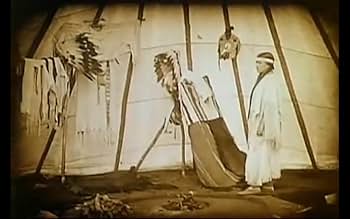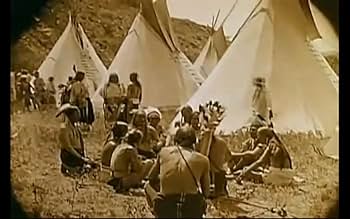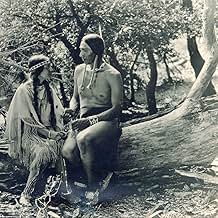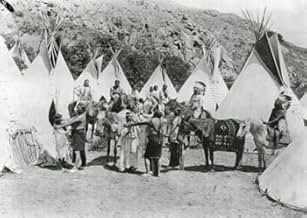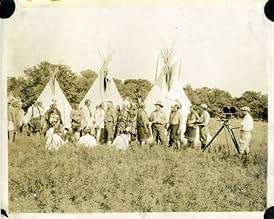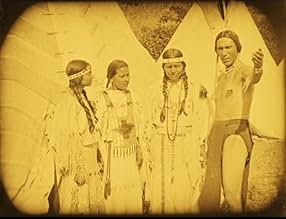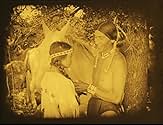Añade un argumento en tu idiomaThis restored silent film features a love triangle involving a Kiowa chief's daughter and ensuing conflict between Kiowa and Comanche villages.This restored silent film features a love triangle involving a Kiowa chief's daughter and ensuing conflict between Kiowa and Comanche villages.This restored silent film features a love triangle involving a Kiowa chief's daughter and ensuing conflict between Kiowa and Comanche villages.
- Dirección
- Guión
- Reparto principal
- Premios
- 1 premio en total
Jack Sankeydoty
- Black Wolf
- (as Sanka Dota)
Belo Cozad
- Big Bear - Comanche Chief
- (as Chief Cozad)
Reseñas destacadas
Esther LeBarre is ready for marriage. Her father, Hunting Horse thinks Jack Sankeydoty would be a good match, but she doesn't love him. She loves White Parker. Hunting Horse set a test for the two suitors, which Sankeydoky fails miserably, so Parker get the girl and Sankeydoky is exiled. So he takes up with the evil Comanche and plots his vengeance.
There's good photography here, showing off the Kiowa in group settings and with the appurtenances of their culture. However, when it comes to acting, no one seems to have much of an idea of how to get a performance out of the Native Americans who made up the cast. Definite props for using Native Americans in the cast instead of White actors, but good intentions don't trump inept acting nor standard plots, and the camerawork by Ray Ries is the dull set-ups that American films got into while European film makers were occupied by a little something called World War One.
There's good photography here, showing off the Kiowa in group settings and with the appurtenances of their culture. However, when it comes to acting, no one seems to have much of an idea of how to get a performance out of the Native Americans who made up the cast. Definite props for using Native Americans in the cast instead of White actors, but good intentions don't trump inept acting nor standard plots, and the camerawork by Ray Ries is the dull set-ups that American films got into while European film makers were occupied by a little something called World War One.
Several articles including a Wiki Article claim this was only shows for a very short period in California. Simple research shows this movie was shown nationwide on it's release. I heard of it because one of the persons who held the distribution rights was a cousin of my grandfather.Heath and Banks held the Southern Distribution rights and first ran it in Dublin, Swainsboro, Claxton and Millen Georgia. That was followed up by dozens of other theaters in South Georgia then all over Georgia. It also ran in Alabama and Florida at the same time.
This restored silent film features a love triangle involving a Kiowa chief's daughter and ensuing conflict between Kiowa and Comanche villages.
There are a few early films that claim to be made by Indians, with Indians, for Indians. This might be the first feature, and it certainly is the only one screened privately for President Wilson. But what makes it stand out is not its historical significance, but what happened to it after.
Besides a few small screenings, the film was not seen... and then vanished. That it showed up many decades later and in such fine condition is incredible. We have movies that are presumed lost and either never turn up, or are found as mere snippets with incredible damage. This one is a bit of a miracle and re-writes the history of Indian cinema. (And I mean Native American cinema, of course.)
There are a few early films that claim to be made by Indians, with Indians, for Indians. This might be the first feature, and it certainly is the only one screened privately for President Wilson. But what makes it stand out is not its historical significance, but what happened to it after.
Besides a few small screenings, the film was not seen... and then vanished. That it showed up many decades later and in such fine condition is incredible. We have movies that are presumed lost and either never turn up, or are found as mere snippets with incredible damage. This one is a bit of a miracle and re-writes the history of Indian cinema. (And I mean Native American cinema, of course.)
"Daughter of the Dawn" has become an interesting historical artifact of a 1920 silent film, long considered lost and restored in 2012, including for a home-video release. Much of what would've made it a curiosity in 1920 remains the same today, as a view into Native-American culture as portrayed exclusively by Native Americans. While the white men behind the camera, as well as the perhaps the similar makeup of the intended audience for the film, offers a perspective of the exotic and a romanticizing of a racial "other," the "noble savage" myth, cowboys-and-Indians fighting minus the cowboys, and a stealing-women plot that's just as at home in "The Searchers" (1956) included, this view is partly subverted by the looks and representation on screen. It's members of the Kiowa and Comanche, although the Comanche oddly remain "othered," representing themselves, including reportedly wearing their own clothes and bringing the tepees to the production--offering a semblance of authenticity to the proceedings and determining to a degree how they would be gazed upon. Even the body language and signaling is a marked contrast to the sort of gesticulation as an extension of intertitles usually seen in silent films. Moreover, "The Daughter of Dawn" is cinematographically based on looks, full of masked views and point-of-views shots, sharing the camera's, and thus our, the spectator's, perspective through the eyes of the Native Americans.
This may be as simple as a character spotting a herd of bison or the lovely forested and hilled spots of Oklahoma Indian Territory. But, the spying on the rival tribe and the creepy shadowing of the love triangle are also based on looks--characters looking and being looked upon, and, indeed, here that mostly means the traditional active male gaze and the female to-be-looked-at-ness. The story is admittedly lackluster and threatens to veer into overwrought melodrama (and doing just that with the character of Red Wing), built as it is on a love triangle that's resolved by White Eagle and Black Wolf (one can tell just by the color in their names which is supposed to be the baddie) being told to literally jump off a cliff and the subsequent wrestling match of supposed tribal warfare. The underlying cause of these struggles, though, is sexual reproduction. Black Wolf points out to the Comanche that they have few young women in their tribe. Their race is dying. The bison hunt plays into this, too, as it's said that the Kiowa face starvation without it.
Furthermore, all of this looking is conspicuous for what it doesn't see. The genocide, forced relocation and cultural marginalization that's the unspoken raison d'être of the picture. There are no white settlers in the film, but they're nonetheless like an unspoken, unseen spectre looming outside the frame--why "The Daughter of Dawn" is a fictionalization of a largely lost culture, constantly pushed onto harsher and less-productive landscapes, the numbers of their tribes being depleted. The cinematographic apparatus here becomes part of that invasion, a means to capture this culture and relocate it to distant screens. When films were treated as disposable goods, only of temporary market worth, even the film was nearly lost. The term "lost" doesn't fully grapple with the destruction wrought, either. They weren't merely misplaced, never to be found again; they were marginalized, mistreated and willfully destroyed.
Some of the few films that do remain, such as "The Daughter of Dawn," which others have mentioned alongside a few other such pictures of the time that feature all-native casts, in addition to even some of the Bison Westerns of Thomas H. Ince's studio, demonstrate that the racist caricatures of Indians in classical Hollywood Westerns promoting Manifest Destiny wasn't always the case. Even in the silent era, there were more sympathetic portrayals and some attempts at greater screen representation. It's fortunate that "The Daughter of Dawn" exists and may be seen instead of romanticized. It's a flawed picture, but a valuable one that deserves to exist and be seen.
This may be as simple as a character spotting a herd of bison or the lovely forested and hilled spots of Oklahoma Indian Territory. But, the spying on the rival tribe and the creepy shadowing of the love triangle are also based on looks--characters looking and being looked upon, and, indeed, here that mostly means the traditional active male gaze and the female to-be-looked-at-ness. The story is admittedly lackluster and threatens to veer into overwrought melodrama (and doing just that with the character of Red Wing), built as it is on a love triangle that's resolved by White Eagle and Black Wolf (one can tell just by the color in their names which is supposed to be the baddie) being told to literally jump off a cliff and the subsequent wrestling match of supposed tribal warfare. The underlying cause of these struggles, though, is sexual reproduction. Black Wolf points out to the Comanche that they have few young women in their tribe. Their race is dying. The bison hunt plays into this, too, as it's said that the Kiowa face starvation without it.
Furthermore, all of this looking is conspicuous for what it doesn't see. The genocide, forced relocation and cultural marginalization that's the unspoken raison d'être of the picture. There are no white settlers in the film, but they're nonetheless like an unspoken, unseen spectre looming outside the frame--why "The Daughter of Dawn" is a fictionalization of a largely lost culture, constantly pushed onto harsher and less-productive landscapes, the numbers of their tribes being depleted. The cinematographic apparatus here becomes part of that invasion, a means to capture this culture and relocate it to distant screens. When films were treated as disposable goods, only of temporary market worth, even the film was nearly lost. The term "lost" doesn't fully grapple with the destruction wrought, either. They weren't merely misplaced, never to be found again; they were marginalized, mistreated and willfully destroyed.
Some of the few films that do remain, such as "The Daughter of Dawn," which others have mentioned alongside a few other such pictures of the time that feature all-native casts, in addition to even some of the Bison Westerns of Thomas H. Ince's studio, demonstrate that the racist caricatures of Indians in classical Hollywood Westerns promoting Manifest Destiny wasn't always the case. Even in the silent era, there were more sympathetic portrayals and some attempts at greater screen representation. It's fortunate that "The Daughter of Dawn" exists and may be seen instead of romanticized. It's a flawed picture, but a valuable one that deserves to exist and be seen.
¿Sabías que...?
- CuriosidadesThe film was begun in 1919 and finished in 1920. For some unknown reason it was never released, and was thought to have been lost. However, in 2005 an original silver nitrate print turned up, and it was purchased by the Oklahoma Historical Society, which embarked on a painstaking restoration project. The film was finally restored and premiered in Oklahoma in 2012.
- Citas
[first lines]
Kiowa Chief: Go in search of White Eagle and learn whether he has seen the game we have long been looking for. Our women and children can go hungry no longer.
Selecciones populares
Inicia sesión para calificar y añadir a tu lista para recibir recomendaciones personalizadas
- How long is The Daughter of Dawn?Con tecnología de Alexa
Detalles
- Duración
- 1h 20min(80 min)
- Color
- Mezcla de sonido
- Relación de aspecto
- 1.33 : 1
Contribuir a esta página
Sugerir un cambio o añadir el contenido que falta

